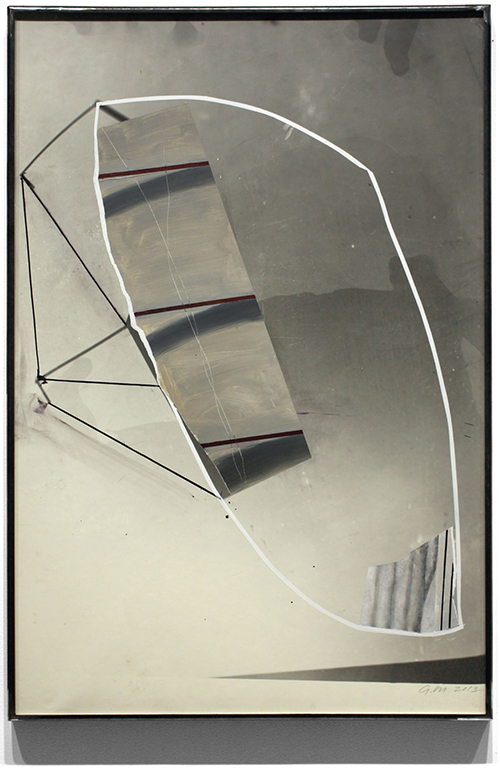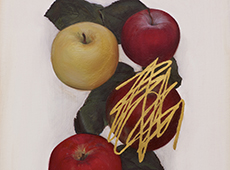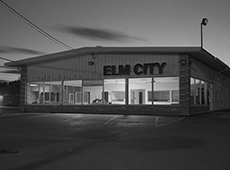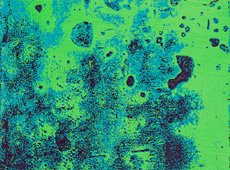After a while it became very obvious that not only was there a great deal of potential there for drawing, there was a great deal of potential there for painting. And that’s really the simple way in which the work I have been doing in drawing and painting for the last 8 years was generated.

Gordon Moore, “Untitled, 2012.” Ink and gouache on photo emulsion paper. 40 x 27 inches. © Gordon Moore. Courtesy of Betty Cuningham Gallery.
III
Somewhere along the way, about 20 years back, I built a darkroom in a studio I had in a big building with other artists in Jersey City, which has since been torn down. I often had a darkroom all the way back to undergraduate school in Seattle and I had always taken 35mm black and white photos with an old Nikon I had, having been very influenced by the post war 35mm photographs of Robert Frank and Lee Friedlander. And I always loved watching images come up in the tray as they were being processed.
Growing up in Kansas one of the best things my parents ever gave me were these trips we would take every summer to one of the coasts or up to Canada and back. They were amazing in the 50’s, and I saw the whole United States fly by the back seat window of first a ‘54 Chevy and then a ’57 Buick. The stuff I saw. So when I came across Frank’s The Americans, which he shot in 1956, I almost fell over. I was just totally blown away because I had absolutely lived those photographs and there’s one in that extraordinary book which he took of a Hotel window in Butte, Montana that I actually DID live. And I told him that years later. So anyway, I had built this darkroom back then, originally to process photographs I had decided to take of the World Trade Center, somewhat in abstraction, on clear days. Every time I went over to my studio in J.C. I kept walking by the World Trade Center and it seemed to me that no one had ever photographed it the way I was seeing it. So I decided to do this bookwork of these photographs and I had to stop painting for a while to do this. I wanted to shoot it in 6 x 6 with Tech-Pan, a film they don’t even make anymore, so it would be in high resolution. So I went out to Hempstead, Long Island and bought this reconditioned Rollei-Flex from a dealer out there named Jimmy Koh, who was the real thing. He had worked for Franke & Heidecke in Germany. It’s just this great camera. And I started doing this bookwork on this WTC book which I built out of aluminum and the next thing I know is like a year goes by and all the while I’m doing this I keep noticing that there is something very painterly about the way developer flows over photo-emulsion paper, sometimes dripping and running and especially when the developer is almost exhausted and dirty, weird shit can happen. And so I start playing around and notice that if you take the print out to sunlight just after stop, weird tonal color starts coming up in black and white paper, the tone and color of which varies depending on the make and brand of the paper.
After a while it became very obvious that not only was there a great deal of potential there for drawing, there was a great deal of potential there for painting. And that’s really the simple way in which the work I have been doing in drawing and painting for the last 8 years was generated. It may be only a nominal difference, but it’s not so much photography as darkroom-process, which was the source because very often there’s very little photographed and many times nothing is actually photographed. And I’m talking here only about drawing on top of the print out of the darkroom for drawings only. I never collage photo-prints onto paintings. The idea of such a thing is apocryphal to me! Painting is paint. At one point I had taken a 35mm picture of a metal strap configuration I saw on a subway wall. I still don’t know what it actually was. It was just there and I liked the configuration. I pulled it up on 8 x 10 paper and used it as a ground to draw on top of and immediately there was this depth, which I was of course interested in, and that’s how the drawings really started. And people responded. After that I realized that I could just put tape in any configuration I wanted on a wall and use that as the ground. I use the Rollei-Flex because I can pull it up to roll size paper, and if you play around and doge under the enlarger you can completely disconnect the linear element of the tape from its attachment to the wall. And that’s very interesting to me as a starting point for a drawing. You simply cannot tell really what you’re looking at and I’ve often had to point it out to people because they can’t tell what is in the photo-paper from what is on the photo-paper. There are problems of course, but you work them out. Humidity acts on photo-paper very differently than on ordinary paper. And the surface can be very difficult to control ink on top of. But there are ways to do what you want and there are virtues also. Photo-paper is very tough. It can take tape easily and is remarkably archival if you fix and wash it properly. That’s the only thing I do properly. Other than that I try to violate every known darkroom procedure there is because I end up drawing on it. That’s the whole idea. At this point I don’t think I’ll work on anything but photo-paper for drawings.
spacer
Up next:
“…I started adding pumice into the mix, originally as a dulling agent. And the more I did that, the more I realized that enough layers of that mix created what I came to call a ‘paint slab’ that completely covered the surface…”
Our conversation with Gordon Moore continues.
spacer
.
.
.
.
Subscribe to Tilted Arc
If you like this story, please consider subscribing. We are sticklers for privacy.
We will never sell or share your e-mail address.



